The Journal of Biological Chemistry (JBC), published by the American Society for Biochemistry and Molecular Biology (ASBMB), has a legendary reputation for zero-tolerance on research fraud, papers of certain problematic authors have been retracted en masse. In May 2020, a publishing partnership between ASBMB and Elsevier was announced. Unfortunately and not entirely unexpectedly, things went to sh*t from there. The recent appointment of Alex Toker as JBC Editor-in-Chief is the final nail in the coffin of this journal’s ethics revolution.
It was predictable. The ethics champion ASBMB with its flagship journal JBC and the unscrupulous, dominant and greedy monster Elsevier were never a suitable pair, even as ASBMB tried to insist on its independence. ASBMB literally sold its soul to the devil, for actual money, and will now pay the price for it.

The first thing Elsevier did was to reformat the JBC online articles. Figures are available in low resolution only, composite image extraction from PDFs not possible anymore. All this serves to prevent external experts like Clare Francis, Elisabeth Bik or Smut Clyde from sleuthing. The result will be certainly less research fraud, in an Elsevier way.
The ASBMB fraud fighter and founder of the journal’s ethics policies, the former JBC chief editor and professor at Vanderbilt University in Nashville Fred Guengerich, is retiring by the end of 2021. He will take his legacy with him, and there is nobody left at ASBMB who will cry for it. The image integrity expert Kaoru Sakabe, whom I had the honour to interview on the occasion of the Elsevier partnership, left ASBMB soon after to work in the pharma industry. Many others have left, while wrong people got appointed to power positions. JBC has been assimilated by the Else-Borg.
Happy Days
Remember the good old days when we all celebrated JBC?
In 2017, the Israeli cancer researcher Rony Seger lost 9 JBC papers in one go, his colleague Yehiel Zick followed in 2018 with 3 retractions, apparently their Weizmann Institute was taken by surprise as ASBMB was cracking down on Weizmann fraud.
In 2019, a scandal shook Spain when the cancer and ageing researcher Carlos Lopez-Otin saw 8 of his papers retracted by JBC in one go, for which I blame Smut Clyde and myself. The retractions prompted Spanish science elites and even the local government to threaten a violent retaliation against ASBMB, but just before the Spanish Armada was ready to sail off and cannon-ball the publisher’s offices in Rockville, Maryland, chaos ensued when St Carlos of Oviedo first lost a Nature Cell Biology paper, then his Nature mentoring award, and eventually his mind, having started to preach spiritual gobbledygook and to flirt with Opus Dei.
Also in 2019, the only retraction which the French minister for Research and Innovation and former rector of University of Nice, Frederique Vidal, could not prevent, happened at JBC. At least France didn’t threaten a war on ASBMB like Spain did!
The Australian cancer researcher Levon Khachigian, for whom The Lancet is prepared to bite every critic’s head off, earned first one, then 3 more JBC retractions (which now appear backdated to 2010, thank you Elsevier).
In 2020, the Italian neuroscientist Elisabetta Ciani, defended by her University of Bologna and Italian charities, only had to retract papers at JBC and nowhere else. All other publishers accepted the rector’s decree that no misconduct happened, one journal even ratted out the whistleblower to Ciani.
The biggest case of mass-withdrawals were the recent 16 retractions at JBC for China’s top immunologist, Communist Party top cadre, army general, and chairman for research integrity, Xuetao Cao. Those retractions happened despite Cao having been largely whitewashed by Chinese authorities and just before the Elsevier deal was sealed in May 2020. Do you think Elsevier would have allowed its journal to annoy the Chinese Communist Party like this?
And then things went down the drain. In 2019, ASBMB was sued by the Pittsburgh pulmonologist Raju Reddy, who wanted to overthrow his JBC retraction which he himself signed following an institutional misconduct investigation. The lawsuit dragged on, and in January 2021, already assimilated by Elsevier, ASBMB signed a court settlement, which basically means they did not win that frivolous lawsuit Reddy brought against them. Trust me as someone who was repeatedly sued himself: since JBC did not retract the retraction or issued an apology, they had to compensate Reddy in another way. I.e., with money. Which makes further retractions at ASBMB journals much less likely.
Abandon Ship!
Soon after the Elsevier partnership was announced, people have been leaving the publishing division of ASBMB in worrying numbers. Just like the data integrity manager Sakabe, the publishing technology manager, Julie Stoner, left ASBMB in the second half of 2020. JBC‘s technical editor Martin Spiering left already in July 2020 and now works for APA.
In October 2020, Sakabe’s successor Isabel Casas joined ASBMB, without any experience in the publishing industry whatsoever. Which was not at all a problem for the duties of a data integrity manager, but just two months later Casas was appointed ASBMB’s Director Of Publications, in charge of all journals, JBC, Molecular & Cellular Proteomics (MCP), and Journal of Lipid Research. And in charge of research integrity there.
Maybe this is why ASBMB suddenly saw the need to create the job of Assistant Publications Director, so that person can help Dr Casas gather experience with her new job? In any case, the new rein by Dr Casas (who did not reply to my emails) brought some serious personnel changes.
First, Nancy Rodnan, the experienced Senior Director of Publications, retired in February 2021. Prior to her, the Peer Review Coordinator Pam Booth, retired also. That was nothing unusual in itself. But then, in spring 2021, other people, much younger, left and found new jobs elsewhere:
- Emily Huff, Publications Manager, MCP, left ASBMB after 7 years, to start half a year later at Medscape
- Catherine Goodman, Scientific Editor of JBC, left ASBMB after 5 years, and now works for ACS.
- Masha Pasho, Manager of Journal Operations and Support, left ASBMB after 4 years and now works for ASPET.
- Hugo Minera, Image Analyst, left ASBMB after 4 years and works for a health magazine.
- Anand Rao, Science Communicator, left ASBMB after 2 years and works for pharma industry
- Tracey Kirkbride, Journal Data Analyst and Peer Review Coordinator, left ASBMB having worked there since 2019 at least.
- The job of the current ASBMB data integrity manager Chad McCormick has been posted as open from October 2021 here. Which means he is about to leave also, after 3 years at ASBMB.
Well done by the new Director of Publications, these people couldn’t really all have been stupid, lazy or stealing pencils. Maybe it is not such a great thing that they all left, rather simultaneously when the new leadership arrived? Or does ASBMB expect Elsevier to run the shop now, contradicting their own past assurances of editorial independence? Is this why these staff members had to go, them being redundant to Elsevier’s mighty algorithms?
And now the 5 year term of the previous JBC Editor-in-Chief Lila Gierasch, professor at University of Massachusetts Amherst, ended. So which academic scientist will succeed her?
Cantley alumnus
Meet Alex Toker, associate director for the Cancer Research Institute at Beth Israel Deaconess Medical Center and professor of pathology at Harvard Medical School, whose appointment as JBC Editor-in-Chief was announced by ASBMB in July 2021.
The current ASBMB president was quoted:
“Alex has a compelling vision for the future of the JBC,” said Toni Antalis of the University of Maryland School of Medicine, president of the ASBMB. “He was a standout candidate in our search, being a distinguished scientific leader with a strong commitment to the editorial processes and best practices that are the hallmark of the JBC. I believe the JBC will flourish in the open-access environment under his leadership and will continue to foster the dissemination of scientific advances that serve the scientific community.“
Well, that’s nice to know. After all, Toker is the former postdoc of the star scientist of Weill Cornell, Lewis C Cantley (27 papers on PubPeer). Toker, who runs his own lab for over 20 years now, is still going to Cantley’s lab retreats, and is also rumoured to be friends with another star in Harvard, Carl Ronald Kahn. I once mentioned Kahn, who has 40 papers on PubPeer and still is seen as one of America’s greatest scientists, in this article.
Kahn also has 3 retractions, two of which in JBC. Like this one, retracted in 2017 and featuring Toker’s ex-boss Cantley.
Kohjiro Ueki , David A. Fruman , Claudine M. Yballe , Mathias Fasshauer , Johannes Klein, Tomoichiro Asano, Lewis C. Cantley, C. Ronald Kahn Positive and negative roles of p85 alpha and p85 beta regulatory subunits of phosphoinositide 3-kinase in insulin signaling Journal of Biological Chemistry (2003) doi: 10.1074/jbc.m305602200


Good that this fraud festival was dealt with before Toker arrived as Editor-in-Chief, eh? But Cantley is also untouchable, that was his only retraction so far. I wrote about his problematic papers already twice. First, here:
Then, also in this article about the amazing characters in mTOR research. Cantley closely collaborates with John Blenis, whom Cantley also personally recruited to Weill Cornell. And Blenis published oodles of fraud, currently 21 papers on PubPeer.
You might say, surely the elite medical school Weill Cornell can crack down on all that shenanigans going on in the Cantley and Blenis labs? Maybe I should drop an email to the dean Augustine MK Choi, to have these data fudgers sorted out? What do you think?
The Weill Cornell dean has 40 papers on PubPeer, some of them in JBC. Maybe Cantley will put a good word in with Toker?
Now that Toker is loyal to his daddy Cantley, and to his uncle and Cantley’s friend Blenis, how will the new JBC Editor-in-Chief decide upon this paper, for example?
Andrew R. Tee, Rana Anjum, John Blenis Inactivation of the tuberous sclerosis complex-1 and -2 gene products occurs by phosphoinositide 3-kinase/Akt-dependent and -independent phosphorylation of tuberin Journal of Biological Chemistry (2003) doi: 10.1074/jbc.m303257200
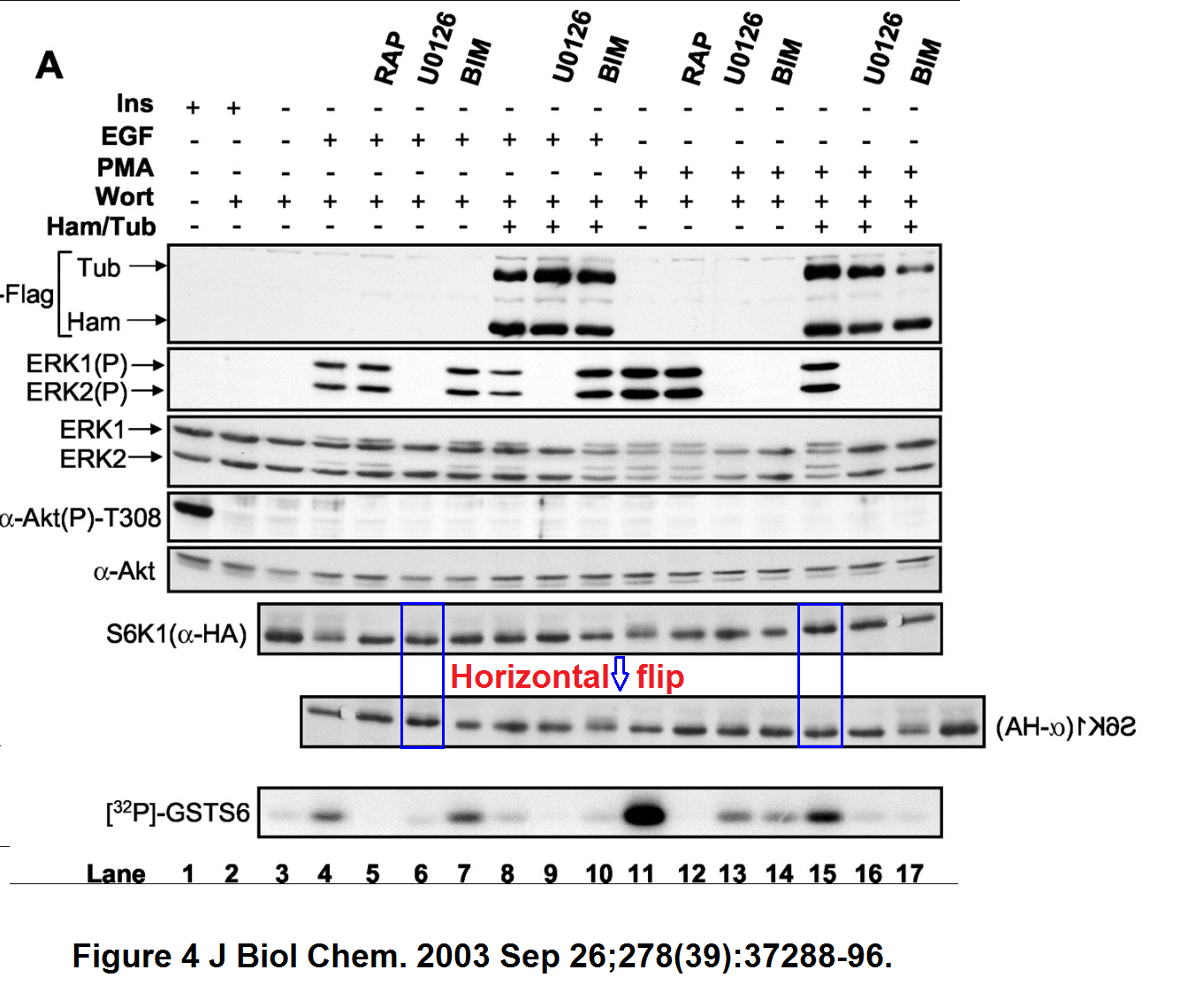

But you might object – why I am banging on about other people’s papers, what do they matter in the context of Toker’s own research, right?
Deep sense of pride
OK then. Let’s see what Clare Francis found in Toker’s own papers. Here is what the future Harvard professor published with his uncle Blenis, ages ago:
Angela Romanelli , Kathleen A. Martin, Alex Toker , John Blenis p70 S6 kinase is regulated by protein kinase Czeta and participates in a phosphoinositide 3-kinase-regulated signalling complex Molecular and Cellular Biology (1999) doi: 10.1128/mcb.19.4.2921


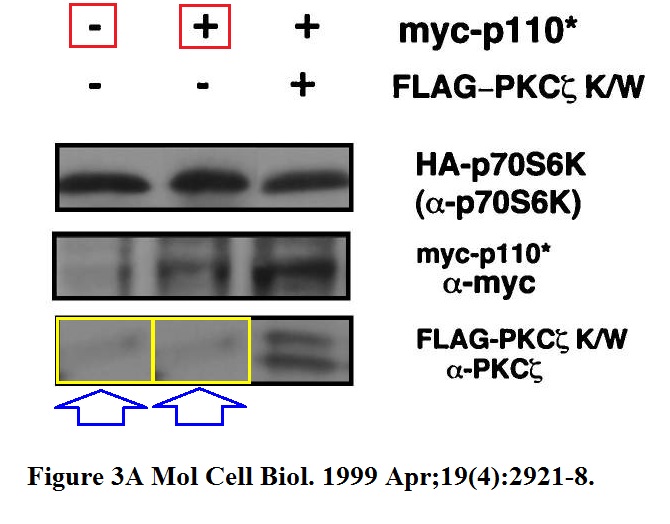
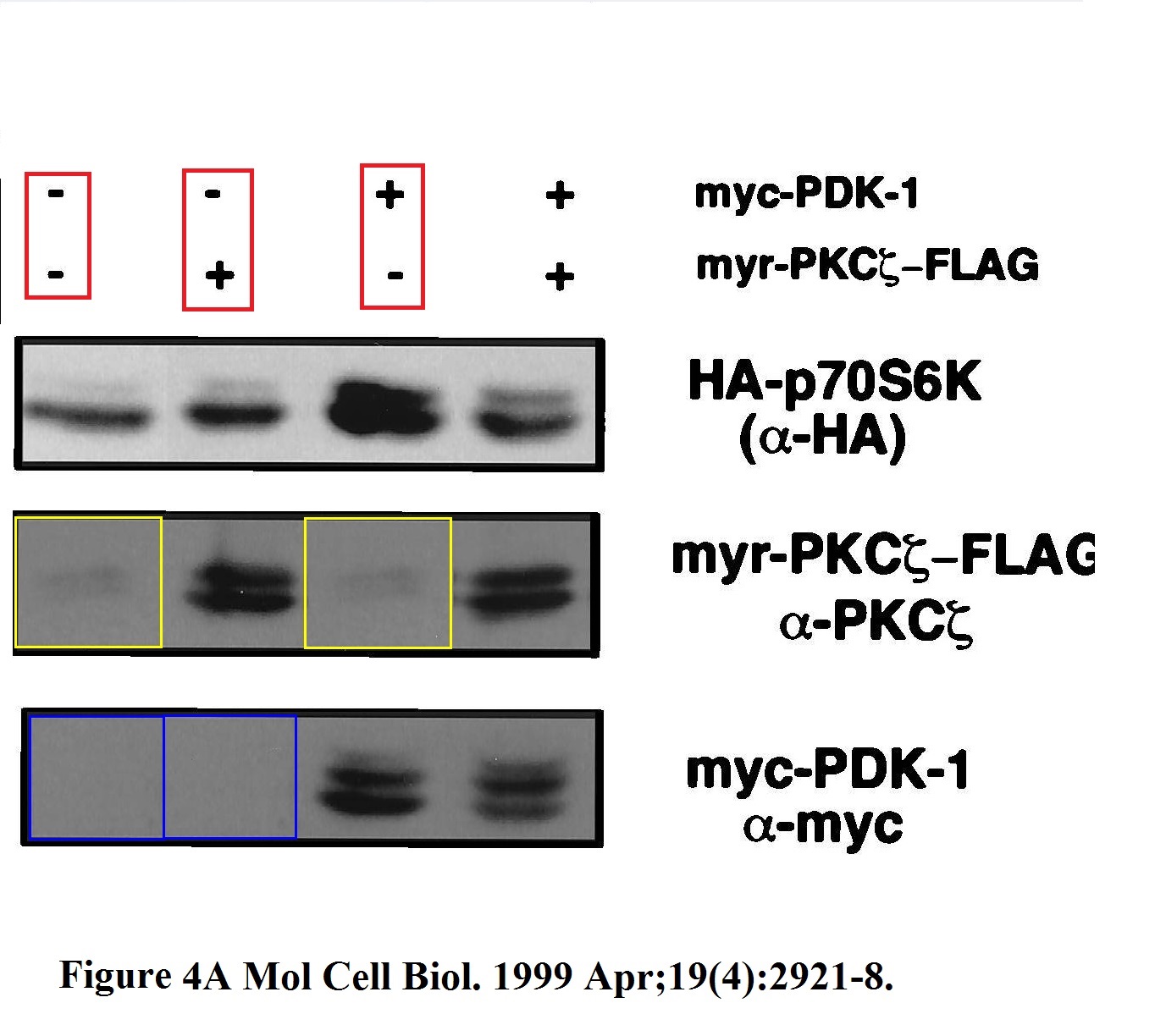
This vintage Photoshop fraud was flagged on PubPeer in November 2020, and yes, Toker (just like Blenis) was notified each time by email, hence the tack next to his name on PubPeer. But Toker was busy preparing himself to commandeer the publications ethics at JBC, you see.
Toker is a big JBC fan, in the ASBMB press release he is reminiscing about his time in Cantley’s lab:
“In 1995, Toker published the first of many papers in JBC. “I recall with a deep sense of pride publishing in the JBC as a postdoctoral fellow, and thereafter as a principal investigator with my own lab. I have always considered the JBC the premier journal in biochemistry and cell and molecular biology,” he said. “I recall as a postdoc in the 1990s, my adviser would pass around the weekly JBC issue, with that unmistakable green cover, having scribbled the initials of each grad student or postdoc next to each paper in the table of contents. This was our signal to read that paper!”
When he started his own lab, Toker published in JBC papers like this:
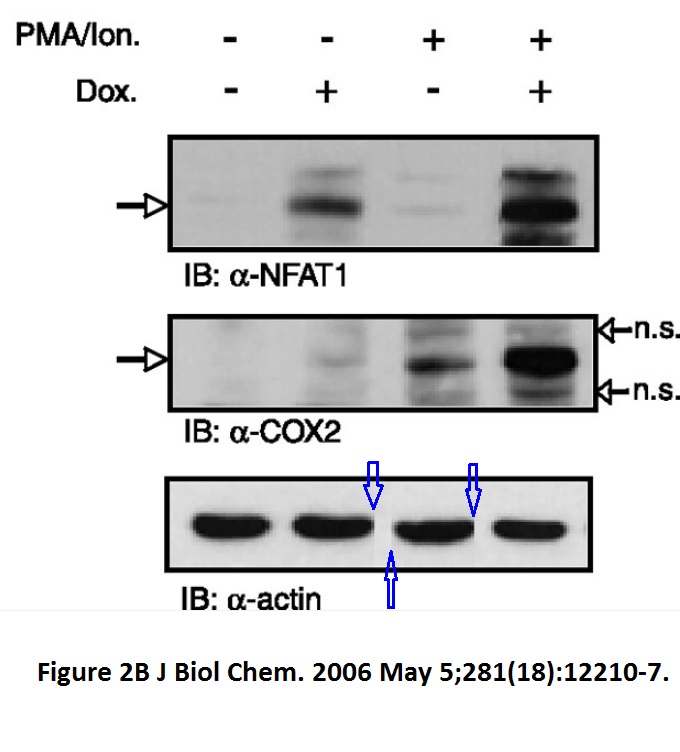
Gary K. Yiu , Alex Toker NFAT induces breast cancer cell invasion by promoting the induction of cyclooxygenase-2 Journal of Biological Chemistry (2006) doi: 10.1074/jbc.m600184200
That’s a gel band which was digitally spliced in because someone disagreed with the original experimental result and because it’s just a loading control so who cares. Those who think loading controls are important are failed scientists anyway.
Another one?

Gary K. Yiu , Aura Kaunisto , Y. Rebecca Chin , Alex Toker NFAT promotes carcinoma invasive migration through glypican-6 The Biochemical journal (2011) – doi: 10.1042/bj20110530
More stealth gel splicing because, come on, everyone did it back then, well the failed scientists didn’t do it maybe, but this is why they failed, these losers never got to publish in top journals like the Cantley-trained winners, right?
Merav Yoeli-Lerner , Gary K. Yiu , Isaac Rabinovitz , Peter Erhardt , Sebastien Jauliac , Alex Toker Akt blocks breast cancer cell motility and invasion through the transcription factor NFAT Molecular Cell (2005) doi: 10.1016/j.molcel.2005.10.033
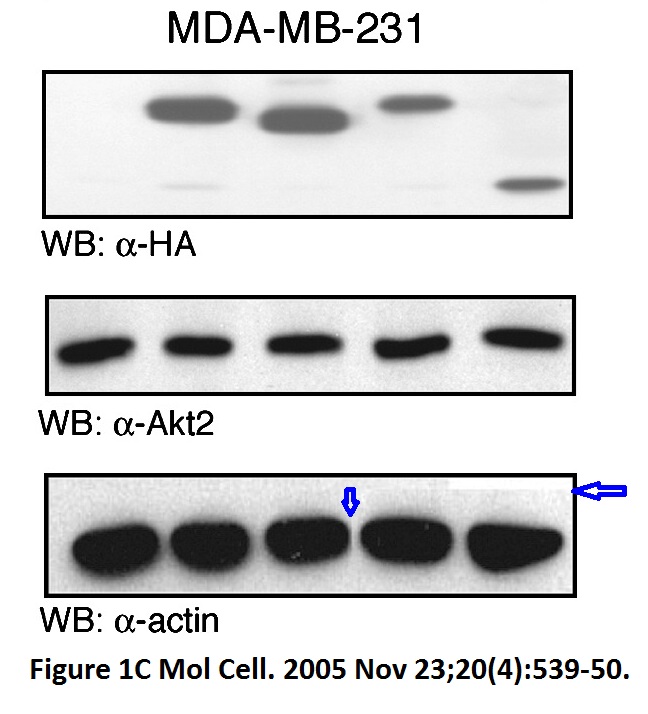
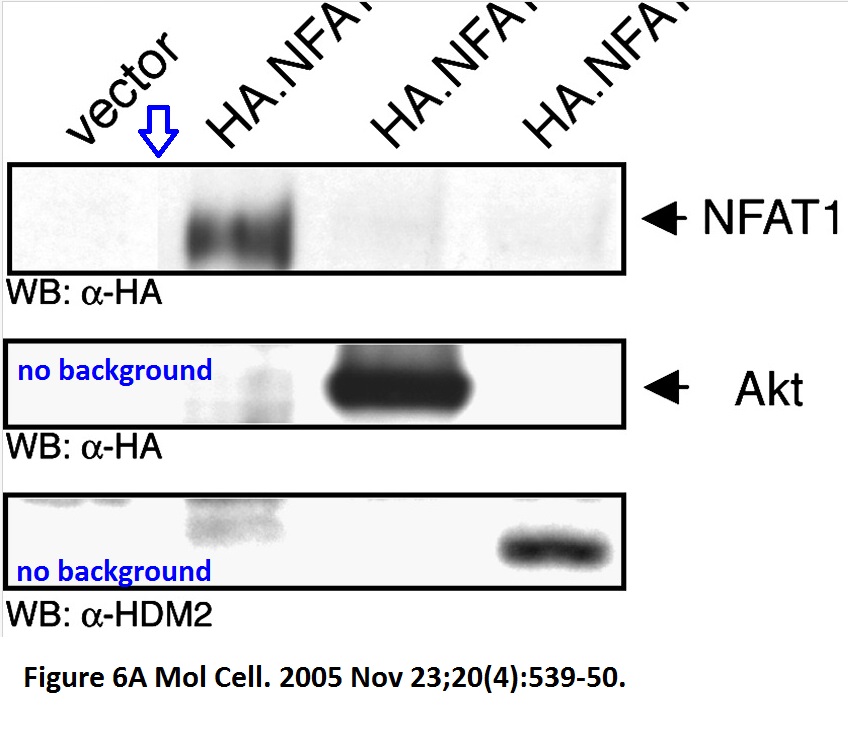

Toldya, it’s just loading controls, and if not, the results were reproduced elsewhere, or so they say. And this kind of data manipulation was legal back then, the rules against gel splicing came only later, 2008 or so! Anyway, the trainee did it.
Here a different set of trainees.
Peter Storz , Heike Döppler , Alex Toker Protein kinase D mediates mitochondrion-to-nucleus signaling and detoxification from mitochondrial reactive oxygen species Molecular and Cellular Biology (2005) doi: 10.1128/mcb.25.19.8520-8530.2005

The insecticide Rotenone is basically the same as H2O2, or wait, it isn’t, hence the different actin loading controls. Anyway, conclusions not affected!
Let’s conclude with some papers Toker published with his Beth Israel Deaconess Medical Center colleague Wenyi Wei. Who in turn is a close associate of Pier Paolo Pandolfi, sacked by same Harvard institute for sexual harassment, then sacked again in Italy because of my reporting on that and the many falsified studies Pandolfi published. I discuss some of Wei’s and Pandolfi’s papers here:
Daming Gao , Hiroyuki Inuzuka , Alan Tseng , Rebecca Y. Chin , Alex Toker, Wenyi Wei Phosphorylation by Akt1 promotes cytoplasmic localization of Skp2 and impairs APCCdh1-mediated Skp2 destruction Nature Cell Biology (2009) doi: 10.1038/ncb1847
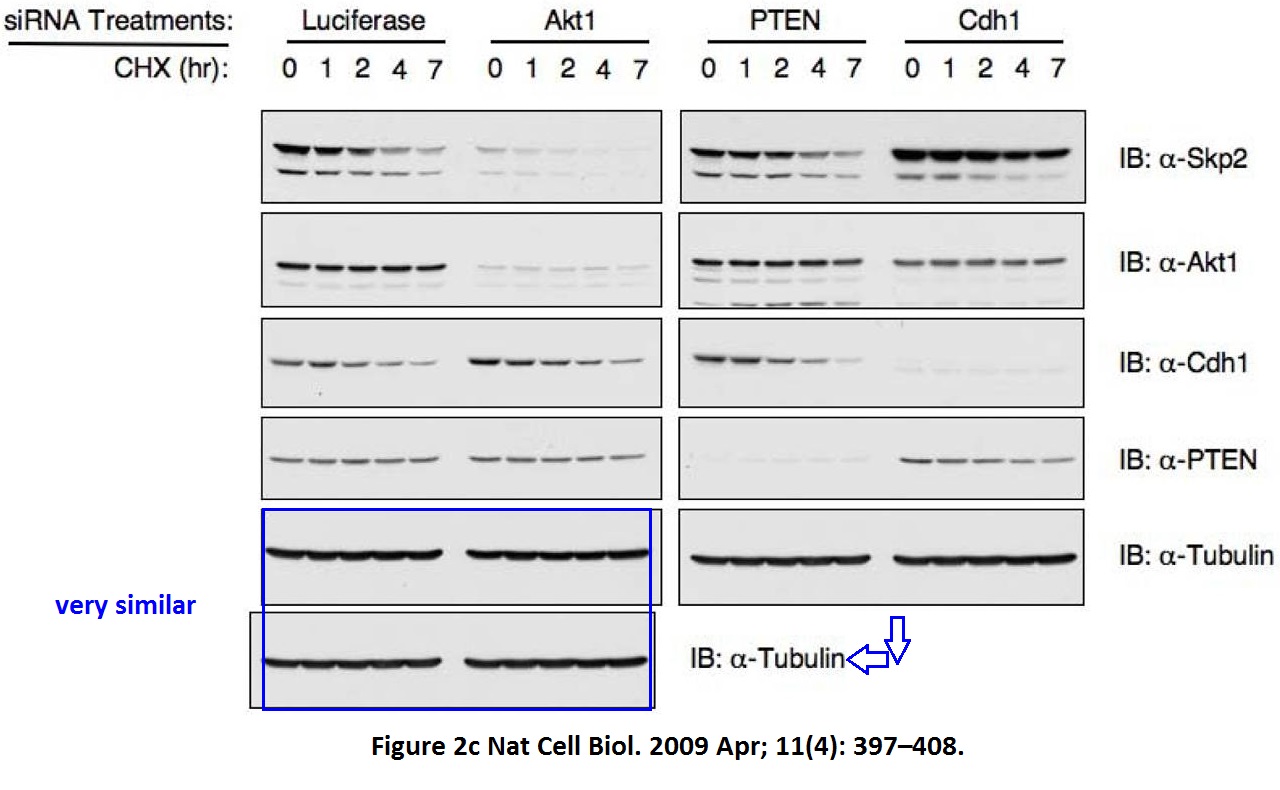
Accidental copy-paste? But why are the images differently cropped then? Oh I forgot, those are loading controls, which merely are supposed to verify that all samples were indeed pipetted equally and that certain samples were not “accidentally” mis-loaded in order to procure a desired result for publication in an elite journal.
Anyway, was this image of a mouse liver also accidentally duplicated, stretched and brightened?
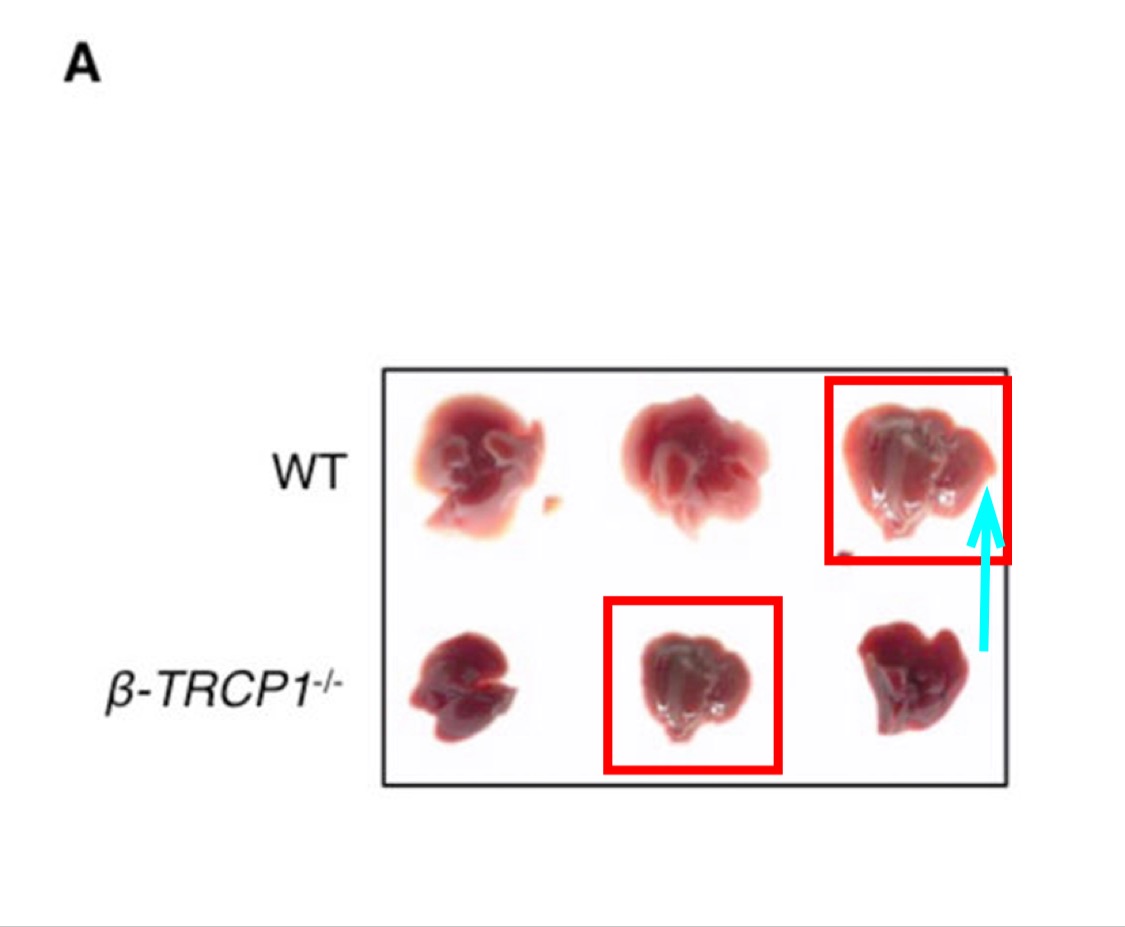
Kouhei Shimizu , Hidefumi Fukushima , Kohei Ogura , Evan C. Lien , Naoe Taira Nihira , Jinfang Zhang , Brian J. North , Ailan Guo , Katsuyuki Nagashima , Tadashi Nakagawa , Seira Hoshikawa , Asami Watahiki , Koji Okabe , Aya Yamada , Alex Toker , John M. Asara , Satoshi Fukumoto , Keiichi I. Nakayama , Keiko Nakayama , Hiroyuki Inuzuka , Wenyi Wei The SCF β-TRCP E3 ubiquitin ligase complex targets Lipin1 for ubiquitination and degradation to promote hepatic lipogenesis Science Signaling (2017) doi: 10.1126/scisignal.aah4117
Dr Toker did not reply to my emails. Also ASBMB never replied, they seem to have no views on such data irregularities all of a sudden.
The situation may appear similar to when the American Society of Plant Biologists recruited for its journal The Plant Cell the wrong Editor-in-Chief with Sally Assmann, who also published falsified data and was therefore replaced before she began her term. But actually it’s different.
This is biomedicine and not plant science. Unlike Assmann, Toker will stay on. Unlike The Plant Cell, the JBC is published by Elsevier. Last time I reported a problematic editor-in-chief to Elsevier, the publisher sent him a letter of support, calling me a “toxic individual” while warning all academic editors never to reply to me.
Elsevier research integrity operates on a simple algorithm. Correct where needed, ignore the rest. Retract only when the corresponding authors or the rare honest chief editors keep asking for it. Play champions of research integrity so those who notice your real game will be sidelined and ignored.
I wonder for how much money did ASBMB sell its soul to Elsevier. And if it was worth it, financially that is. Because in every other respect, it was an utter cock-up. An act of sabotage, but from the inside. A f***ing disaster if you ask me.
Let’s finish with a song.
Make a one-time donation
Make a monthly donation
Choose an amount
Or enter a custom amount
Your contribution is appreciated.
Your contribution is appreciated.
DonateDonate monthly

Please add this imgur to:
J Biol Chem. 2002 Mar 22;277(12):9929-35.
Figure 6. Much more similar than expected.
LikeLike
From: Isabel Casas icasas@asbmb.org
Date: Tue, Jun 29, 2021 at 9:30 PM
Subject: Re: Problematic data J Biol Chem . 2002 Mar 15;277(11):9268-77. doi: 10.1074/jbc.M109221200. Epub 2002 Jan 3.
To: claire Francis claire.francis1492@gmail.com, Lila Gierasch gierasch@biochem.umass.edu
Cc: Frederick P. Guengerich f.guengerich@vanderbilt.edu, Nancy Rodnan nrodnan@asbmb.org
Too old
M. Isabel Casas, PhD
(she/her/hers)
Director of Publications
American Society for Biochemistry and Molecular Biology
6120 Executive Blvd., Suite 400, Rockville, MD 20852
icasas@asbmb.org | http://www.asbmb.org
Journal of Biological Chemistry
Molecular & Cellular Proteomics
Journal of Lipid Research
From: claire Francis claire.francis1492@gmail.com
Sent: Tuesday, June 29, 2021 3:56 PM
To: Lila Gierasch gierasch@biochem.umass.edu
Cc: Frederick P. Guengerich f.guengerich@Vanderbilt.Edu; Isabel Casas icasas@asbmb.org; Nancy Rodnan nrodnan@asbmb.org
Subject: Problematic data J Biol Chem . 2002 Mar 15;277(11):9268-77. doi: 10.1074/jbc.M109221200. Epub 2002 Jan 3.
J Biol Chem . 2002 Mar 15;277(11):9268-77. doi: 10.1074/jbc.M109221200. Epub 2002 Jan 3.
AT1 receptor mutant lacking heterotrimeric G protein coupling activates the Src-Ras-ERK pathway without nuclear translocation of ERKs
Koichi Seta 1, Masakatsu Nanamori, J Gregory Modrall, Richard R Neubig, Junichi Sadoshima
Affiliation
1
Cardiovascular Research Institute, Department of Cell Biology and Molecular Medicine, University of Medicine and Dentistry of New Jersey, New Jersey Medical School, Newark, New Jersey 07103, USA.
PMID: 11777928 DOI: 10.1074/jbc.M109221200
Problematic data figure 8C. Much more similar than expected.
See:
EXTERNAL EMAIL: This
LikeLike
From: Lila Gierasch gierasch@umass.edu
Date: Tue, Jul 6, 2021 at 9:00 PM
Subject: Re: J Biol Chem. 2002 Mar 22;277(12):9929-35. “too old ” for JBC to do anything about it?
To: claire Francis claire.francis1492@gmail.com
Cc: Lila M. Gierasch gierasch@biochem.umass.edu, Fred Guengerich f.guengerich@vanderbilt.edu, Isabel Casas icasas@asbmb.org, Nancy Rodnan nrodnan@asbmb.org
not my call any more, but we did create wording that enabled a judgement call if the infraction was particularly egregious even in older papers…. this looks pretty bad
Sent from my iPhone
On Jul 6, 2021, at 11:04 AM, claire Francis claire.francis1492@gmail.com wrote:
J Biol Chem. 2002 Mar 22;277(12):9929-35. “too old ” for JBC to do anything about it?
J Biol Chem. 2002 Mar 22;277(12):9929-35. Epub 2002 Jan 11.
Mutation in the glucose-6-phosphate dehydrogenase gene leads to inactivation of Ku DNA end binding during oxidative stress.
Ayene IS1, Stamato TD, Mauldin SK, Biaglow JE, Tuttle SW, Jenkins SF, Koch CJ.
Author information
1
Department of Radiation Oncology, University of Pennsylvania School of Medicine, Philadelphia, Pennsylvania 19104, USA.
Figure 6. Much more similar than you would expect. Please note the same constellation of spots in the backgrounds of several lanes.
Lanes 2 and 3 look the same. Lanes 4,5,6 and 7 look the same.
Garbage should not be allowed to become sedimentary rock.
End email.
FYI: https://pubpeer.com/publications/AFF23194CD0044BD79BC81A6479631
LikeLike
Please add this imgur to:
J Biol Chem. 2002 Mar 22;277(12):9929-35.
Figure 6. Much more similar than expected.
LikeLike
An illuminating tweet by Elisabeth Bik on how bad Elsevier really is:
Dear readers of ForBetterScience, please boycott Elsevier. Thank you.
LikeLike
Run of the mill (average) sedimentary rock, first illustrated in 2014.
J Biol Chem . 2004 Feb 20;279(8):6737-45. doi: 10.1074/jbc.M308938200. Epub 2003 Dec 1.
bcl-2 induction of urokinase plasminogen activator receptor expression in human cancer cells through Sp1 activation: involvement of ERK1/ERK2 activity
Daniela Trisciuoglio 1, Angela Iervolino, Antonio Candiloro, Gabriella Fibbi, Maurizio Fanciulli, Uwe Zangemeister-Wittke, Gabriella Zupi, Donatella Del Bufalo
Affiliation
1Experimental Chemotherapy Laboratory, Regina Elena Cancer Institute, Via delle Messi d’Oro 156, 00158 Rome, Italy.
PMID: 14660675 DOI: 10.1074/jbc.M308938200
https://pubpeer.com/publications/677779B8E5B3271022B367980596A4
https://pubpeer.com/publications/677779B8E5B3271022B367980596A4#3
LikeLike
Pingback: AACR deploys Massimo Loda on a mission to cure cancer – For Better Science
J Biol Chem, the place to make archeological discoveries!
First illustrated 2015.
https://pubpeer.com/publications/1A85B0C35BE05D99D8B01052B6072F#2
J Biol Chem . 1997 Mar 14;272(11):7290-7. doi: 10.1074/jbc.272.11.7290.
In skeletal muscle, glucose storage and oxidation are differentially impaired by the IR1152 mutant receptor
M Caruso 1, C Miele, P Formisano, G Condorelli, G Bifulco, A Oliva, R Auricchio, G Riccardi, B Capaldo, F Beguinot
Affiliations collapse
Affiliation
1Dipartimento di Biologia e Patologia Cellulare e Molecolare “L. Califano” and Centro di Endocrinologia ed Oncologia Sperimentale del C.N.R., “Federico II” University of Naples Medical School, 80131 Naples, Italy.
PMID: 9054426 DOI: 10.1074/jbc.272.11.7290
J Biol Chem. 1995 Jun 30;270(26):15844-52. doi: 10.1074/jbc.270.26.15844.
Decreased phosphorylation of mutant insulin receptor by protein kinase C and protein kinase A
C Miele 1, P Formisano, K J Sohn, M Caruso, M Pianese, G Palumbo, L Beguino, F Beguinot
Affiliations collapse
Affiliation
1Dipartimento di Biologia e Patologia Cellulare Molecolare L. Califano, University of Naples Medical School, Italy.
PMID: 7797589 DOI: 10.1074/jbc.270.26.15844
LikeLike
too old
LikeLike
Pingback: The authors continue to stand behind Dilip Shah’s conclusions – For Better Science
Pingback: Longwei Yin corrections, or what’s the point anyway – For Better Science
J Biol Chem had gone quiet for a while, but issued this Withdrawal (J Biol Chem uses the word Withdrawal in the place of the work Retraction).
https://pubmed.ncbi.nlm.nih.gov/37054587/
LikeLike
Spitze des Eisbergs.
LikeLike
What is it about p14ARF? It seems to be outsmarting the greatest minds of this generation.
https://pubpeer.com/search?q=P14ARF+
LikeLike
Wenn Retractionen auftreten, blicken wir nur dunkel durch das Glas.
LikeLike